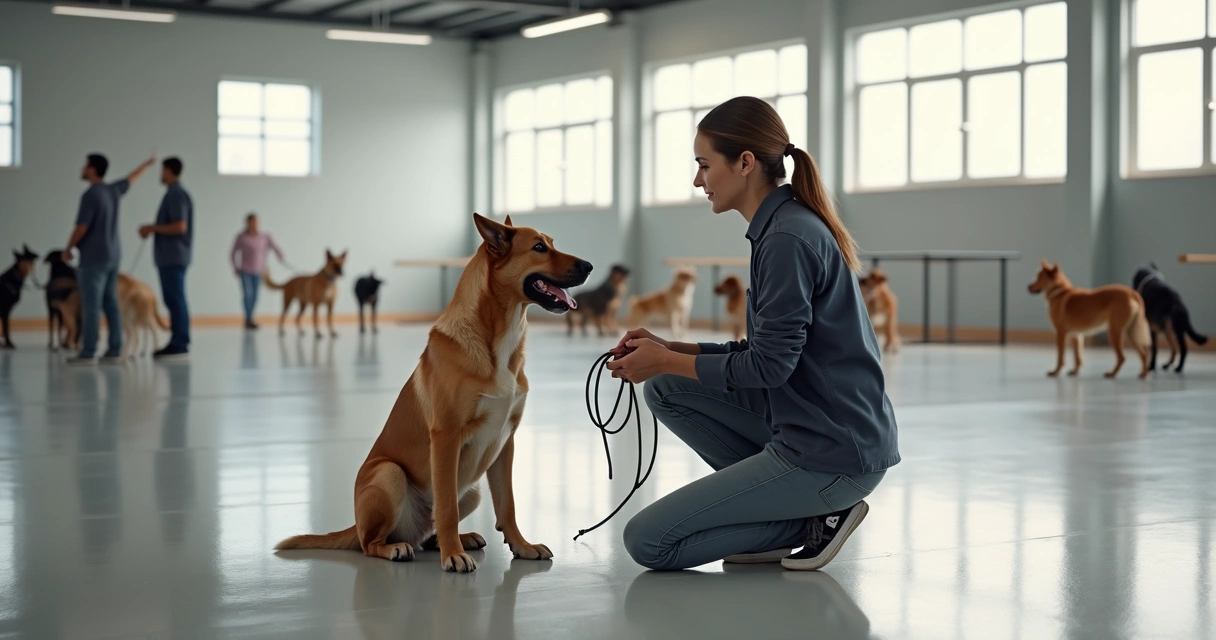If you've ever found yourself torn between signing up your dog for obedience classes or looking for solutions to their quirky, and sometimes downright exasperating, behaviors, you're not alone. In my two decades working with dogs and their families, this is one of the questions I hear most often. Obedience training and behavior correction sound similar, but they actually serve very different purposes. And in my experience, the right approach depends not just on your dog's personality, but also on your own goals as a pet owner.
Understanding obedience training and behavior correction
Sometimes, pet owners use these two terms interchangeably, but there are real differences hidden beneath the surface. Before we get into which one might be right for you, let’s clarify what each really involves.
What is obedience training?
Obedience training is all about teaching your dog clear, structured commands. Sit, stay, come, heel, down – these classic cues are the backbone of obedience work. I always describe it like teaching a child good manners: it’s proactive, setting your pet up for success in daily life and new situations.
In structured environments like Dogtown, trainers use positive reinforcement to encourage dogs and even cats to follow these commands. This method focuses on reward-based learning. The idea is simple: good behavior leads to treats, praise, or affection. Over time, pets learn the desired responses become a habit. This is a far cry from old-school training that relied on harsh words or physical corrections – research confirms reward-based methods are not only more effective but lead to happier, less stressed pets (PLoS ONE research).
How is behavior correction different?
While obedience training is preventative and builds good habits, behavior correction deals with problems that have already emerged. I’ve met many dogs with a repertoire of commands, but serious issues like separation anxiety, aggression, or fear-based reactivity. Their owners often say, puzzled, “But he knows all his commands!”
Behavior correction focuses on:
- Fixing undesired habits (like barking or lunging at visitors)
- Addressing emotional issues (fear of thunder, chewing when alone, etc.)
- Teaching coping skills for high-stress triggers (new people, noises, other dogs)
According to a press release from Texas A&M University, more than 99% of dogs show at least one problematic behavior at some point – with nearly 86% showing issues like attachment, barking, or aggression. So, if you're dealing with stubborn issues at home, it’s more common than most people think.

Why obedience training matters (even if your dog seems fine)
I once worked with a friendly Labradoodle named Daisy. Her owners insisted she didn’t need training because “she’s so sweet at home.” But when Daisy started coming to Dogtown’s daycare and met groups of new dogs, her uncertainty became obvious. She darted around, barked, and ignored staff cues. A few simple sessions on basic commands helped Daisy build the confidence to play kindly – which in turn reduced her owners’ stress at pick-up time.
Good obedience skills open doors.
Here’s what obedience training can bring to any home:
- Safety – Imagine your dog heading toward a busy street. “Come!” can save a life.
- Ease of management – Less frustration during walks or trips to the vet.
- Improved communication – You both speak a language you understand.
- Better socialization – Dogs who listen well tend to get more positive interactions with people and other pets.
And there’s evidence to back up my experience. A study in peer-reviewed research shows that trainer communication, including positive guidance instead of harsh tones, makes dogs respond faster and more reliably to cues. So, it’s not just what you teach, but how you teach it.
What about real behavior problems?
Let’s face it: Sometimes, “sit” and “stay” aren’t enough. A dog barking through every thunderstorm or reacting aggressively to other dogs needs more than a treat for good behavior. That’s where behavior correction comes in.
At Dogtown, we see dogs struggling with:
- Excessive fear or anxiety (like cowering, trembling, or hidden growling)
- Separation distress (destructive chewing, howling when left alone)
- Aggressive reactions (lunging, snarling at people or pets)
- Obsessive habits (chasing shadows, constant licking, or pica – eating non-food items – which affects many dogs according to Japanese research)
Behavior correction is about uncovering the “why” behind problem behaviors and working to change the habit or emotional response itself. It’s rarely a quick fix. Sometimes, it takes patience, structure, and a mix of management strategies to actually solve the problem. But in my experience, dogs who receive targeted, compassionate support see real improvements in quality of life.
Deciding what’s right for your pet
I’m a huge believer in tailoring the approach to both the animal and the family. Here’s how I tend to break down the decision:
- If your goal is:
- Better listening at home or in public
- Making walks easier or more fun
- Preparing your dog for dog parks, day camp, or group play
- A calmer, happier daily routine
- If your main concerns are:
- Dangerous, persistent, or disruptive habits
- Stress or fear that seems to last no matter what you try
- Unpredictable behavior in specific situations
- Issues that make living together difficult or even risky

How Dogtown combines both for lasting results
One lesson I’ve learned is that no two dogs – or their people – are exactly the same. At Dogtown, we often start with a free pre-enrollment assessment to help families spot what their pets really need. Sometimes that means starting from scratch with basic cues. Other times, it’s diving into a custom plan for severe fears or trouble spots (which can range from grooming to boarding experiences).
What stands out to me is the “whole pet” approach. Staff look at everything, including daily routines, playgroups, and even grooming habits (read more about grooming services). If your pet stays overnight, the team also factors in stress-reduction during boarding.
It’s never about a single lesson or treatment. Instead, support from staff continues as long as your pet needs, with ongoing feedback and chances to adjust the plan.
Research: Why problems are so common (and how that impacts your choice)
I think it helps to remember that behavioral quirks are actually the norm. With over 99% of U.S. dogs showing at least one problematic behavior, and nearly 50% displaying fear or anxiety symptoms, investing in training or correction isn’t a sign of “bad ownership.” It’s simply part of life with animals.
Dogs who struggle with concerning behaviors often face longer waits for adoption (peer-reviewed research on shelter stays). Families who work proactively often see not just a more peaceful home, but much happier pets.
Conclusion: The next step for you and your pet
In all my years working alongside dogs, the most satisfying transformations have come when owners take the time to find the right blend of obedience training and behavior correction. Sometimes, it’s just one or the other; sometimes, it’s both. The real trick is being honest about your pet’s needs – and your own hopes for your life together.
Start where you are. Choose what helps your dog, and joy follows.
If you’re not sure where to begin, reach out for a free assessment at Dogtown. Our team will help you build an experience that’s truly personalized for your companion – whether that’s fun in group activities, expert training, or focused behavior support. Give your pet the chance to thrive, and see for yourself how different life can feel.
Frequently asked questions
What is obedience training for dogs?
Obedience training teaches dogs basic commands like sit, stay, come, and heel, using positive reinforcement such as treats or praise. It sets the groundwork for safe, respectful living at home and in public spaces. Regular practice and clear communication are keys to results, and I find that consistency works wonders over time.
What is behavior correction?
Behavior correction is about tackling problem habits or emotional issues after they’ve started. This can include anything from barking at visitors, fear-based reactions, or aggression toward other animals. The main focus is understanding why the problem exists and using humane, effective strategies to help your dog respond differently in future situations.
How do I choose between them?
If your challenge is teaching manners or commands, obedience training is usually the best start. However, for persistent anxiety, aggression, or habits that hurt quality of life, behavior correction is likely necessary. Many families find a mix of both is ideal. I’d recommend seeking a personalized assessment, like the ones we offer at Dogtown, to help you figure out what best fits your needs.
Is behavior correction worth the effort?
Yes, behavior correction can greatly improve your dog’s happiness and your peace of mind at home. Though it takes patience and sometimes professional guidance, I’ve seen even longstanding issues turn around. Dogs become less anxious, owners feel more confident, and everyone enjoys more harmony.
How much does obedience training cost?
Costs vary depending on location, trainer qualifications, and whether you choose one-on-one or group formats. At Dogtown, we offer several package and à la carte options tailored to your goals. Pricing tends to depend on the specifics of your dog’s situation, so I recommend booking a preliminary assessment for an exact quote.





